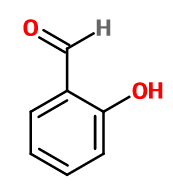
Photo credits: ScenTree SAS
Do you sell any of the raw materials? Would you like to let our users know?
Send an email to fournisseurs@scentree.coto learn about our advertising opportunities.
Do you sell any of the raw materials? Would you like to let our users know?
Send an email to fournisseurs@scentree.coto learn about our advertising opportunities.
General Presentation
-
CAS N° :
90-02-8 -
EINECS number :
201-961-0 -
FEMA number :
3004 -
FLAVIS number :
05.055
-
JECFA number :
897 -
Volatility :
Head/Heart -
Price Range :
€€
Physico chemical properties
-
Appearance :
Colorless liquid -
Density :
1,146 -
Refractive Index @20°C :
1,570 - 1,576 -
Optical rotation :
Data not available. -
Vapor pressure :
0,79 hPa @25°C -
Flash Point :
78°C
-
Molecular formula :
C7H6O2 -
Molecular Weight :
122,12 g/mol -
Log P :
1,66 -
Fusion Point :
2°C -
Boiling Point :
197°C -
Detection Threshold :
30 ppb (0,000003%)
Chemistry & Uses
Uses in perfumery :
Salicylaldehyde is used in warm, almond and coumarinic notes.
Year of discovery :
Data not available.
Natural availability :
Salicylaldehyde is found naturally in small quantities in Ceylon Cinnamon EO.
Isomerism :
The ortho and meta positional isomers of Salicylaldehyde are little used in perfumery, although they also have a bitter almond, very hot, balsamic and sweet smell.
Synthesis precursor :
Salicylaldehyde is the main precursor to Coumarin synthesis by a Perkin reaction with acetic anhydride. It can also form a Schiff base by reaction with Methyl Anthranilate or Indole for example.
Synthesis route :
Salicylaldehyde is synthesized by a Reimer-Tiemann reaction, reacting phenol with potash and chloroform. Then, the aldehyde function implants in the ortho position with respect to the alcohol function.
Stability :
Aldehydes may form diethylacetals in alcoholic perfumes, with no real impact on their smell
Most of the time, the occurrence of a benzenic cycle in a molecule causes a coloration of this molecule through time
Other comments :
Salicylaldehyde is produced by certain insects.
Regulations & IFRA
Allergens :
This ingredient is classified as an allergen under European Regulation 2023/1545, dated August 26, 2023.
Its presence must therefore be declared on product labels when it exceeds 0.001% in leave-on products and 0.01% in rinse-off products.
IFRA 51th :
This ingredient is not restricted for the 51th amendment

